DriveLife has partnered with BMW New Zealand to showcase some of the amazing landscapes, roads and attractions in New Zealand while promoting sustainable mobility. BMW is committed to this topic and has challenged us to take to the roads in a number of BMW’s electric vehicles to experience the superb driving capability and drive range. This collaboration reflects the growing trend towards electric vehicles globally and in New Zealand.
A recent study conducted by BMW has shown that 53% of New Zealanders would consider purchasing an electric vehicle at some point in the future. With the X-Factor challenge, DriveLife will see how far these electric vehicles have come and also encourage people to experience the versatility of driving them on several adventurous weekends away, across beautiful New Zealand.
The same survey suggests electric vehicle ownership will surpass combustion-powered vehicles by 2035 in New Zealand. That’s a bold claim, which means they have to be able to handle some travelling, as Kiwis love their road trips.

Vehicle – BMW iX3
Our second X-Factor weekend starts in New Plymouth and we trek down SH43, known as The Forgotten World Highway and finishing the journey in Taupo. For those who do not know, The Forgotten World Highway lives up to its name and could also be described as the middle of nowhere squared. It is a 149 km stretch of road that links Stratford and Taumarunui, also commonly known as State Highway 43. But the term state highway is being used in its loosest sense, as about a quarter of the route is a gravel track. This is probably why it’s got the lovable name of the Forgotten World Highway. What better road to test the limits of one of the BMW X fully electric vehicles?

As three out of four New Zealanders expressed concern about running out of charge due to the lack of nearby charging stations, it’s a great way to put the first vehicle through its paces.
This is the second scenic trip for me in a BMW EV, (DriveLife and BMW X-Factor Weekend – Wairarapa) I had some company on the first one, but as the schedules worked out, I had to do this one solo. Most of the EVs DriveLife reviews slot into our daily lives, but this experience will be different and should help clear some common concerns and superstitions surrounding EVs, offering a perspective on their practicality and performance.
The BMW iX3 is more conventional than the previous iX we brought to the Wairarapa. The iX was redesigned from the ground up, while the iX3 is the current X3 with a fully electric powertrain. The iX3 boasts a 461 km range and an electric consumption of 18.5 kWh/100km, which makes it ideally suited for everyday life and long weekend trips away. Over the course of the weekend, we will be able to see just how well the BMW iX3 stands up to its claims.


Inside the iX3 has a very spacious cabin with plenty of room for a tall driver like myself. All the seats are super comfy and ergonomic which made it so easy to find that just-right position. The interior was black leather with a nice light blue stitch running through the entire cabin. A great little salute to the EV powertrain is the blue EV BMW logo on the steering wheel. Connecting my phone was a breeze and from there I was able to use Android Auto and Google Maps wirelessly throughout the entire trip.


The iX3, in the Impressive grade level we drove, has a base price is $118,900. It includes a raft of standard equipment including adaptive LED headlights, adaptive suspension, climate control, head-up display, panorama glass sunroof and metallic paintwork. Its luxury and comfort features include electric seat adjustment, seat heating for the front, wireless charging, automatic climate control, and the powerful Harmon/Kardon surround sound system.
Additional features on our test car included a towbar ($2600), sun protection glazing ($1200), and BMW Shadowline ($700) – which provides a slick black trim option over the regular chrome – bringing the as-tested total to $123,400.

Day 1 – Friday – New Plymouth

Our latest adventure starts in New Plymouth where I arrived in the afternoon and checked into our overnight accommodation, One Burgess Hill. Located 5 km outside of New Plymouth CBD, it’s a luxury venue nestled into the countryside right beside the Waiwhakaiho River. I stayed in a single-bedroom townhouse that overlooked the river. It was so peaceful, and it created the perfect setting to start our next EV road trip adventure.

Our first stop and only stop this afternoon was to Pukeiti on the North face of Mount Taranaki. Pukeiti is an internationally recognised garden with one of the most diverse collections of rhododendrons and exotics in the world. Sadly, the weather had different plans for us, as it rained for most of the Friday afternoon. This also created a lot of low cloud cover, which blocked out any views of Mount Taranaki.



Pukeiti is open all day every day and hosts a wide range of activities for the whole family. As mentioned, there is a world-famous collection of rhododendrons, as well as a Kids Treehouse Trail (a free self-guided activity through the gardens), Rainforest tracks, the Rainforest Learning Centre, an iconic waterwheel, and the Rainforest Eatery Cafe. The gardens and tracks made you feel like you were deep in the wilderness, far away from the hustle and bustle of everyday life. Well worth a visit the next time you are in New Plymouth.



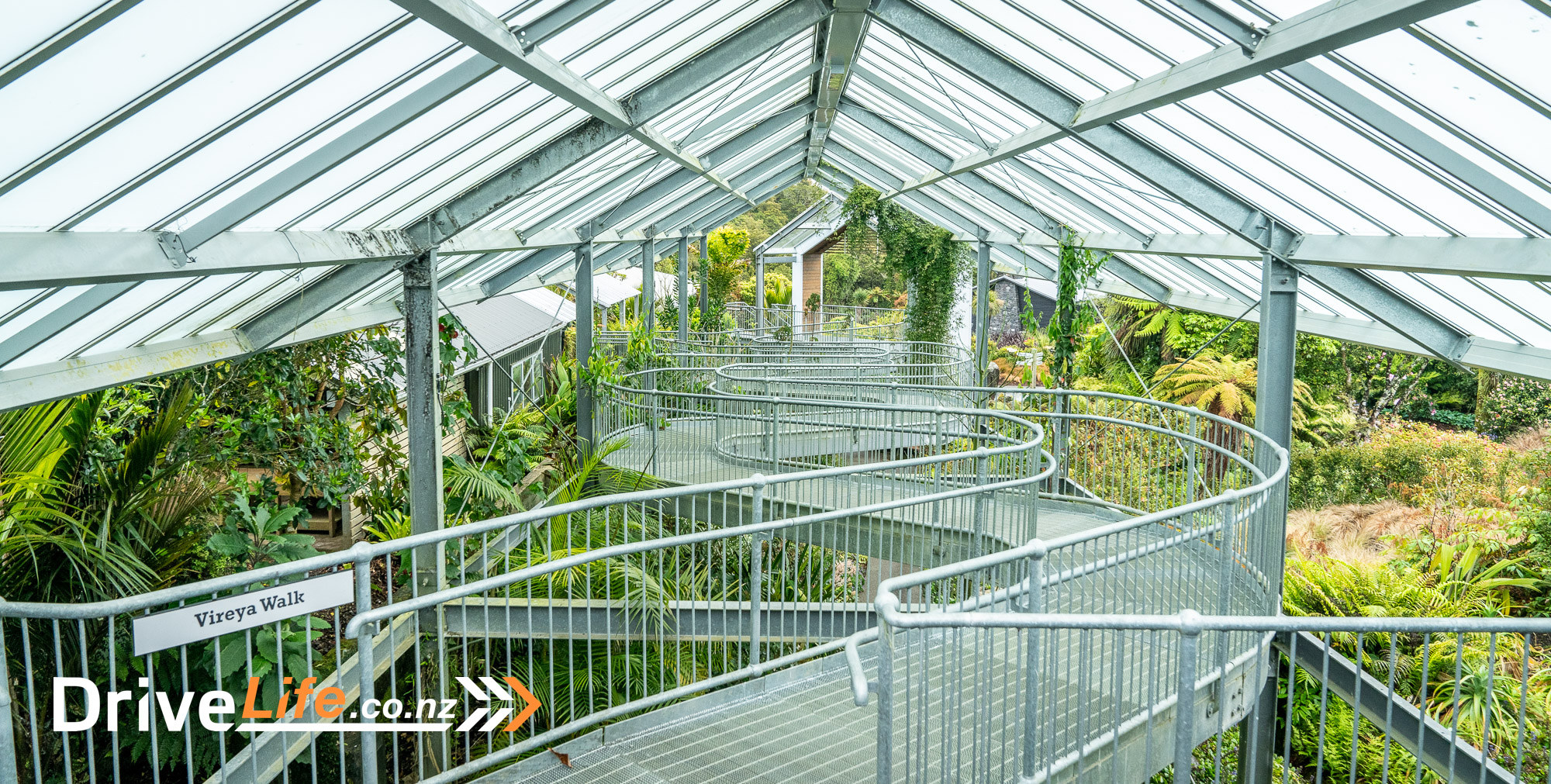
Unlike the previous X-Factor weekend to the Wairarapa in the BMW iX we were unable to charge the iX3 from our accommodation. With some planning and the help of a useful app called PlugShare, I coped just fine with charging the iX3. Plushare is a mobile app that provides information on charging networks around the world. Locations of all the different networks for our trip were ChargeNet, Z EV Charging Stations and Openloop. Plugshare allowed me to work out the best locations to charge throughout the whole trip. As the iX3 had a decent level of battery remaining I decided I would charge when I stopped in Stratford in the morning, at the Z station. It was back to One Burgess Hill and a drink at the Quails Nest Eastery on site.
Day 2 – Saturday – The Forgotten World Highway / SH43 to Taupo

Waking up to a gently running river right outside my window was a perfect start to the day. But it was time to say goodbye and head south to Stratford, 34 km away and the starting point for SH43, The Forgotten World Highway.
As I got into Stratford, my first stop was the Z Station, which has two 180kW EV charging stations. This was great, as it meant I could do a quick top-up while I had a look around Stratford township. The 180kW fast chargers also meant that it would take less time to top right up to 100%, before I set off down SH43.

Stratford has a population of just over 10,000 and is the only town in the Stratford District. It’s famous for its distinctive Glockenspiel clock and the start of the Forgotten World Highway. Stratford borders two national parks and is a gateway to Mt Taranaki, Manganui Ski Field and Dawson Waterfalls. Stratford is also known for the Taranaki Pioneer Village, which is a 10-acre site that allows you to take a nostalgic stroll through yesteryear and experience an outdoor museum presenting the life of Taranaki pioneers in the nineteenth and twentieth centuries.



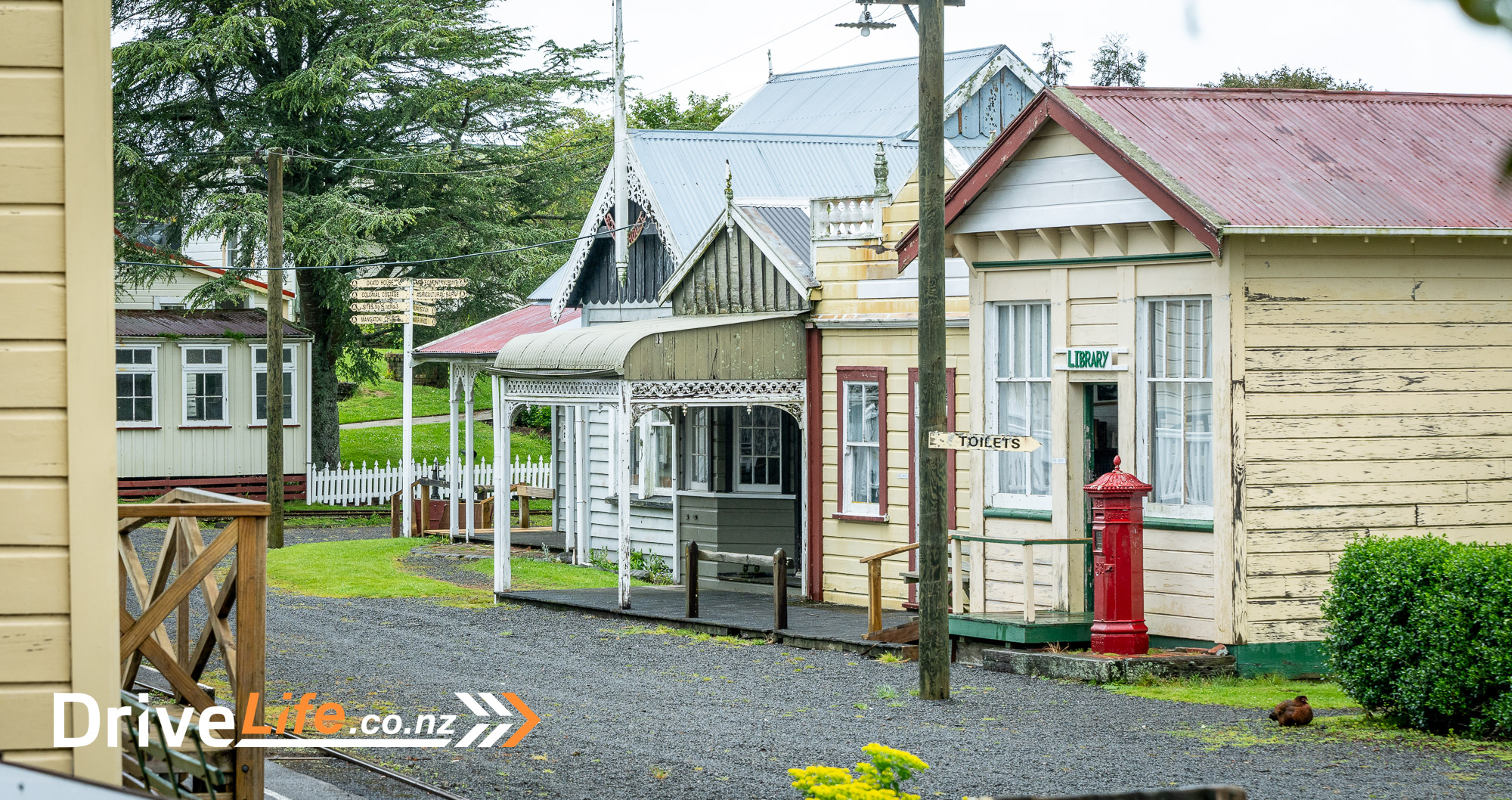

Fully charged, I was ready to start down The Forgotten World Highway with two major stops along the way, one at Whangamōmona (63 km) and the other at Taumarunui (151km). Tamumaruni also marks the end of SH43 and the Forgotten World Highway. It doesn’t take long before you feel like civilisation has been left behind and you’re out on your own in the wilderness. Traffic is very light on this road, but you have to keep your eyes peeled, as cars are not the only thing you might come across around the next bend.

As you venture down SH43, you are instantly spoiled with spectacular views of the many hills and valleys that lay ahead of you. I was only 20 minutes into the trip, and I had stopped several times to get out of the car and take in the scope of where I was and the breathtaking views.

The road has many Heritage Trail signs along the road indicating the regions and saddles you are in. Each saddle is described as a broad stretch of flat land between two mountain summits. As you go in and out of each of these valleys, you will find a lot of interesting information about when the roads or what the area was used for in the early 1900s.


As you get closer to Whangamōmona, you cross over the rail track several times, and each time I couldn’t help noticing the Rail Carts Crossing signs. This was something I was not aware of before the trip and was linked to Forgotten World Adventures. Abandoned since 2009, the 142 km long Stratford-Okahukura Line with its 24 tunnels and 90 plus bridges, all hand-built, now serves as a playground. They offer multiple experiences, from half-day to two-day trips that travel the length of the Stratford-Okahukura Line.

It’s very clear when you get closer to Whangamōmona that it’s not your typical country town. Whangamōmona has a population of 20 people and is famous for its rich frontier history. But it’s also world-famous and on the BBC Travel Guide list. Why, you ask? Well, there was much frustration with local councils, so residents declared it ‘The Republic of Whangamōmona’ in 1989, and held their own presidential elections. Some of the previous presidents include a Turtle, a poodle and a goat. Like I said, things are a bit different in Whangamōmona.

The main building in the town of Whangamōmona is the Whangamōmona Hotel, which offers rooms to stay, and a peaceful social environment to enjoy a few drinks. The hotel hosts many events throughout the year, including the town’s own famous sheep racing competition to name just one. The weekend I stopped by, they were hosting the New Zealand Royal Enfield Owners Register. The Hotel is also where you can get your passport stamped for $2, which shows that you have officially visited the Republic of Whangamōmona.



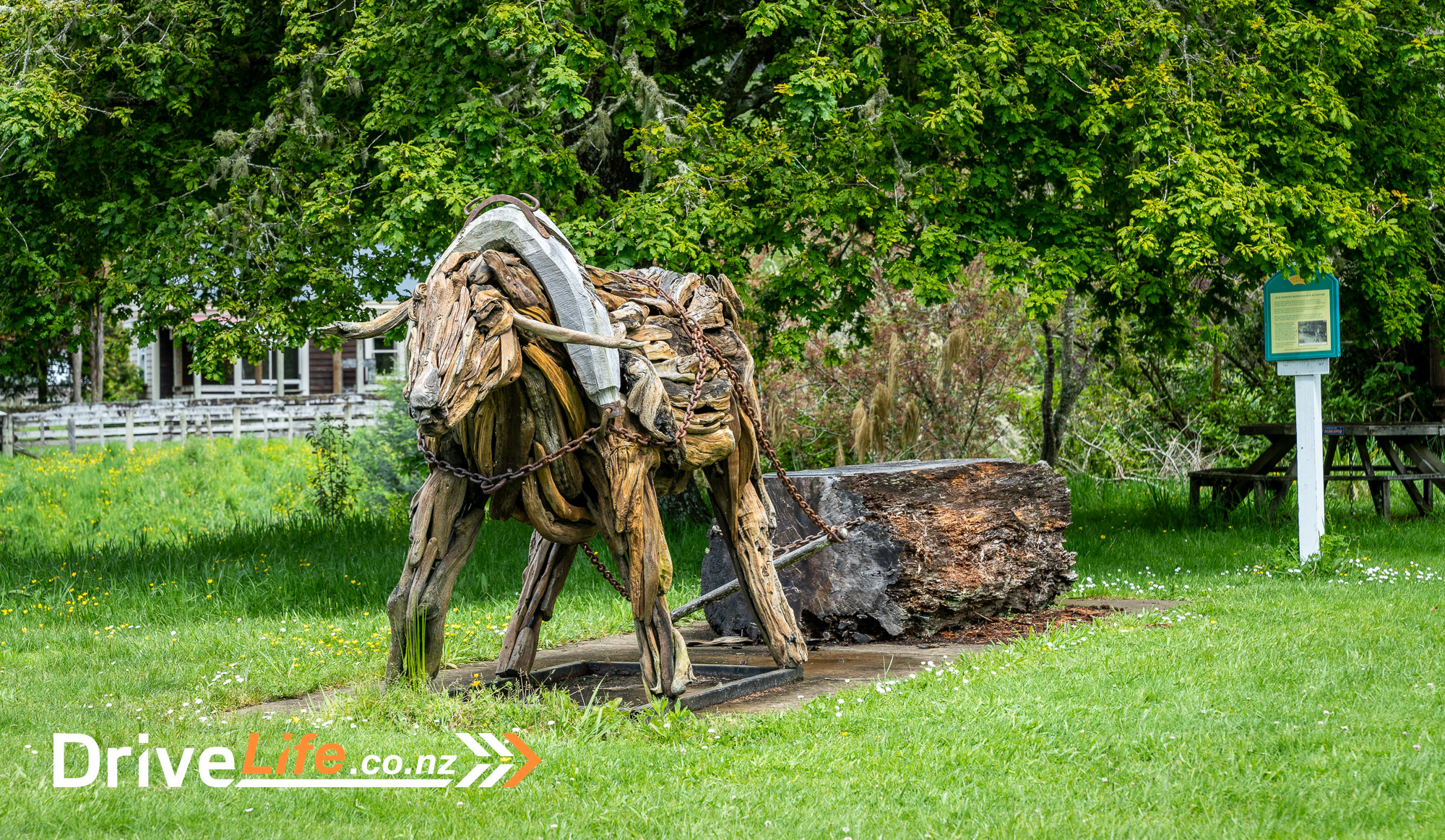

This was not my first time to Whangamōmona, as 12 months before I had been part of a luxury driving event where 80 sports and supercars travelled throughout the North Island. The stretch of road from Stratford to Whangamōmona is an enthusiast’s dream road, with a great mixture of twists and turns and open straights too. But this is as far as we went, as the road further on was gravel, and not ideal for high-performance vehicles. So, we turned around and did the same stretch of road back. Something to note though is the car I did it in used three-quarters of an 80L entire tank of petrol covering the 114 km trip from and back to Stratford. It was a lot of fun, but not very efficient, unlike the BMW iX3, which had barely used a fifth of the battery to get to Whangamōmona.
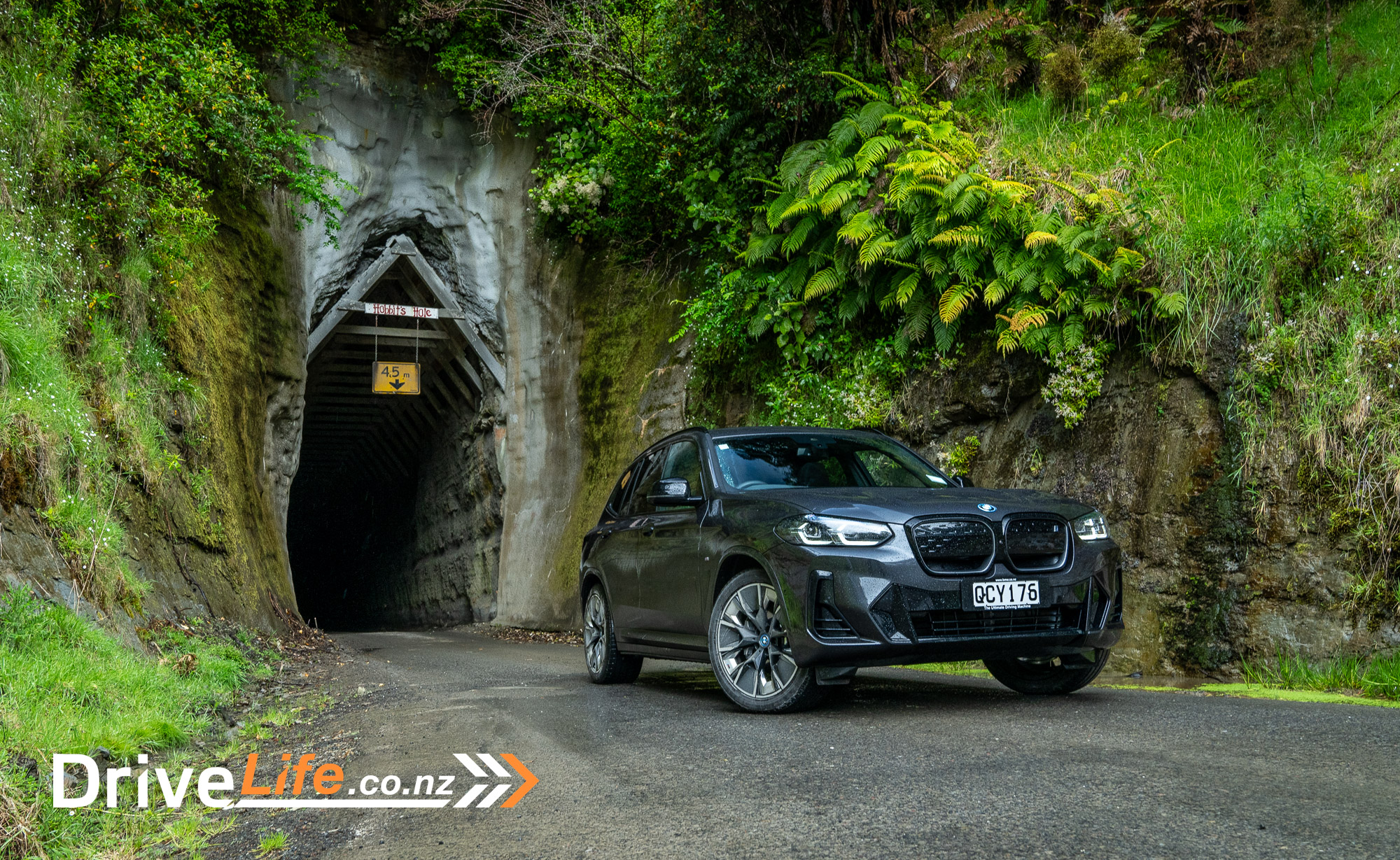
After lunch, it was time to push on down the Forgotten World Highway. At 21km down the road you reach Moki Tunnel, which is aptly named the Hobbit’s Hole. This tunnel is a single-lane that can almost be described as a mine shaft. It’s a tunnel based on the fact it’s got an opening at each end, but that’s where all similarities to vehicle tunnels end. The roof of the tunnel is supported by wooden trusses and the sides of the tunnel are almost as rough as the mountainside around it. There is no lighting which can make you a bit nervous as you drive through the 180 m long tunnel. Once out the other side, you feel like you are setting into a forgotten land like Narnia, or Middle Earth.


Soon after the tunnel, you reach Moki Road at a bit of a crossroads, and around the halfway point of the Forgotten World Highway. Interestingly, Mt Damper Falls is 16km down Moki Road, which piqued my interest, so I set off on a side quest, even deeper into the Taranaki countryside. Sixteen kilometres later, I reached the Department of Conservation sign, indicating that Mount Damper Falls is a 30-minute walk into private land. I had come too far to turn back now, and I really wanted to see the highest waterfall on the North Island. The walk is an easy trek through the country on a maintained DOC track. It snakes through some private farmland, then over a bridge and down a forest path. The track slowly heads downhill and towards the end turns from a walking track into steps down to a lookout area.


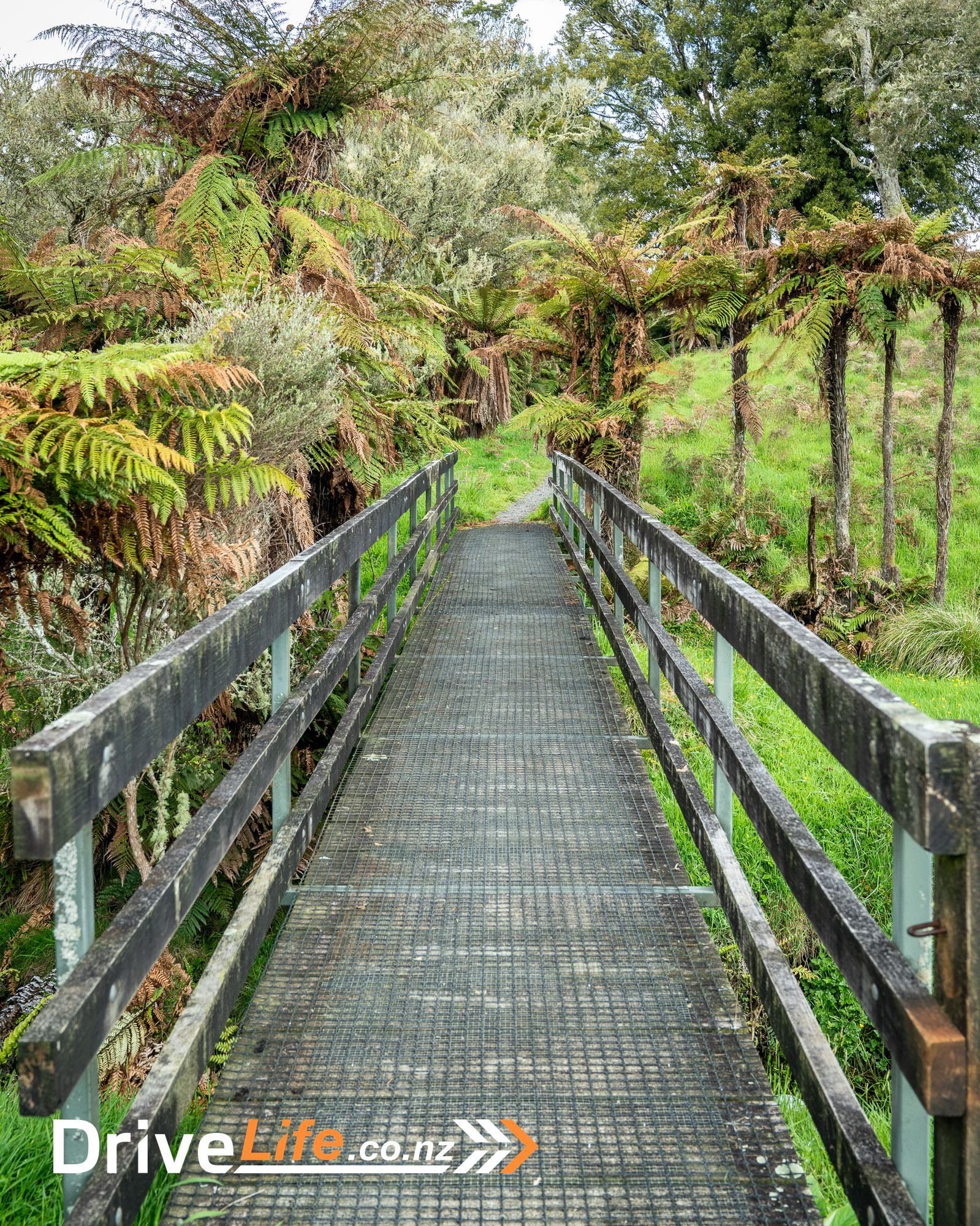



Once at the lookout platform, you get a great view of the 75m waterfall and the surrounding valley. I had not seen anyone on the trek and the last car I saw was back on SH43, so there was a good chance I was the only person around for miles. That was a very freeing feeling, with no noise other than the trees and wildlife, and no phone reception either which gave me a bit more anxiety than the EV range if I am being honest. Another 30 minutes and I was back at the iX3, thankfully right where I left it.
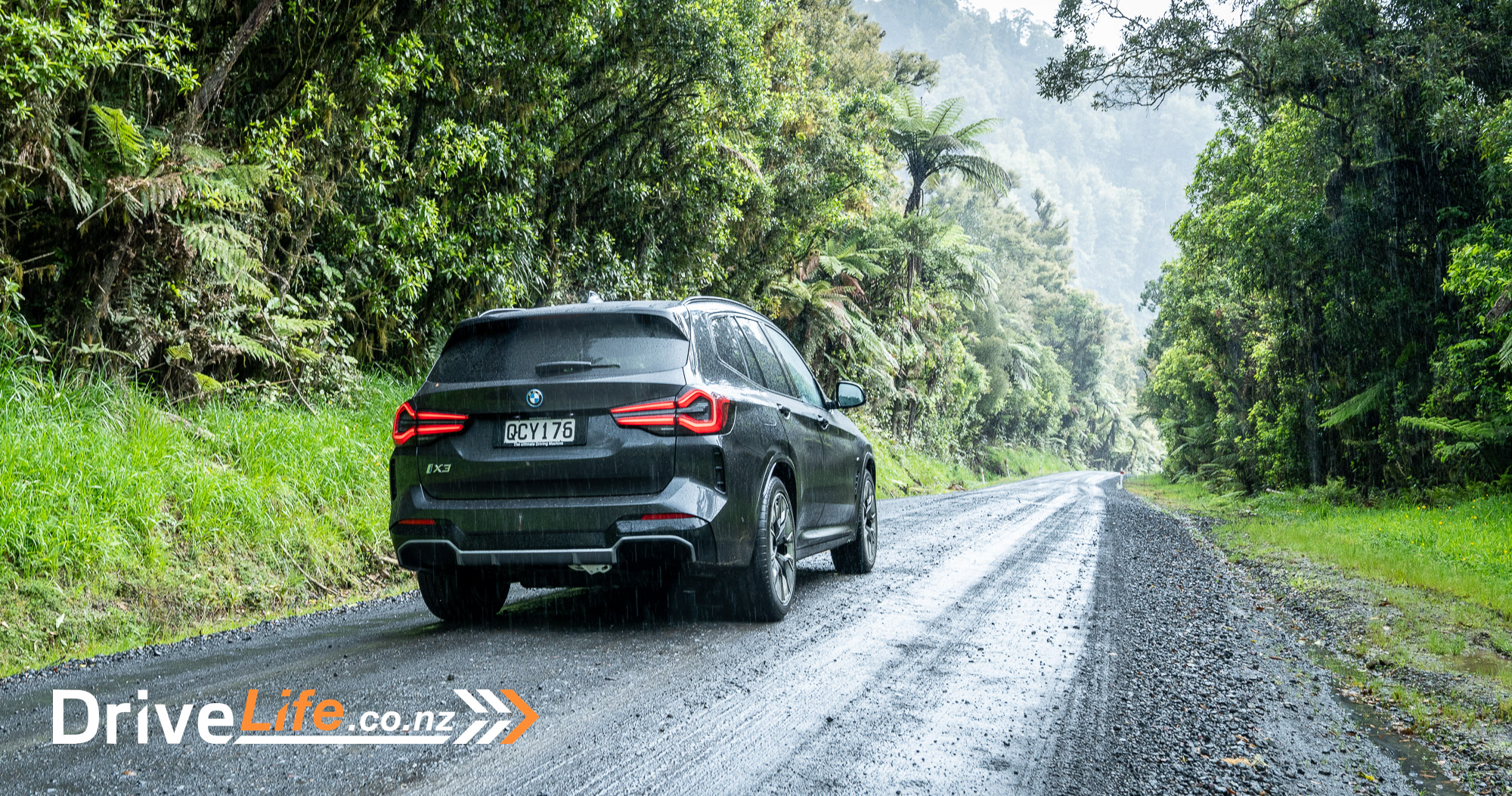
Back on the road once again and I started to feel like I was travelling through time, the road went from tar seal to gravel, and the weather changed in every valley. It rained in one, then it was sunny in the next, fog the next after that. The road surface did get a bit rough at times, nothing that required an offroad vehicle, but it is best to be wary of the ruts in the ground so as to avoid doing any damage to your vehicle. The iX3 handled these stretches of roads without any issues at all, soaking up the even surface very well. Even in areas of loose gravel, the xDrive all-wheel drive system left me with complete confidence behind the wheel. Many stretches of the road can narrow down to a single lane, so take the corners with care and stick to the side of the road you should be on, as there were several times when a car came around a corner and we both had to stop and allow each other room to pass.

This part of the road also crosses multiple single-lane bridges that cross over rivers, gorges, streams etc. Each one is different from the next and many of them I had to jump out to have a look at the stunning landscape around me.
Towards the end of the Forgotten World Highway, 15 km from Taumarunui, there is a beautiful farm called Laruen’s Lavender Farm. This site is home to 8,000 lavender plants and has been family-run and owned since 1999. They have a store and cafe open between October and April, 9 am to 3 pm 7 days a week. The store sells a wide range of beauty products, such as soaps, body washes and body butter – and all hand-made on-site.

The last stretch of the Forgotten World Highway returns to tar seal, which indicates you are heading back to civilization and the town of Taumarunui. The first stop when I got into the town was the charging station, once there I could stretch my legs and grab a bite to eat. On the main street after the visitor’s centre, there is an OpenLoop charging station, with two car parks. No one was using it, so I was able to get the 50kW charger plugged in. Considering that I had covered about 190km the battery range in the iX3 indicated just under 50% left. That meant the time to top up would be around an hour, more than enough time to take a well-needed break.
Home to just under 5,000 people, Taumarunui is best known for its railway history, farming, weaving, golf, and more recently, cycle trails. I took a stroll up and down the main street after grabbing a bite to eat at the local bakery.

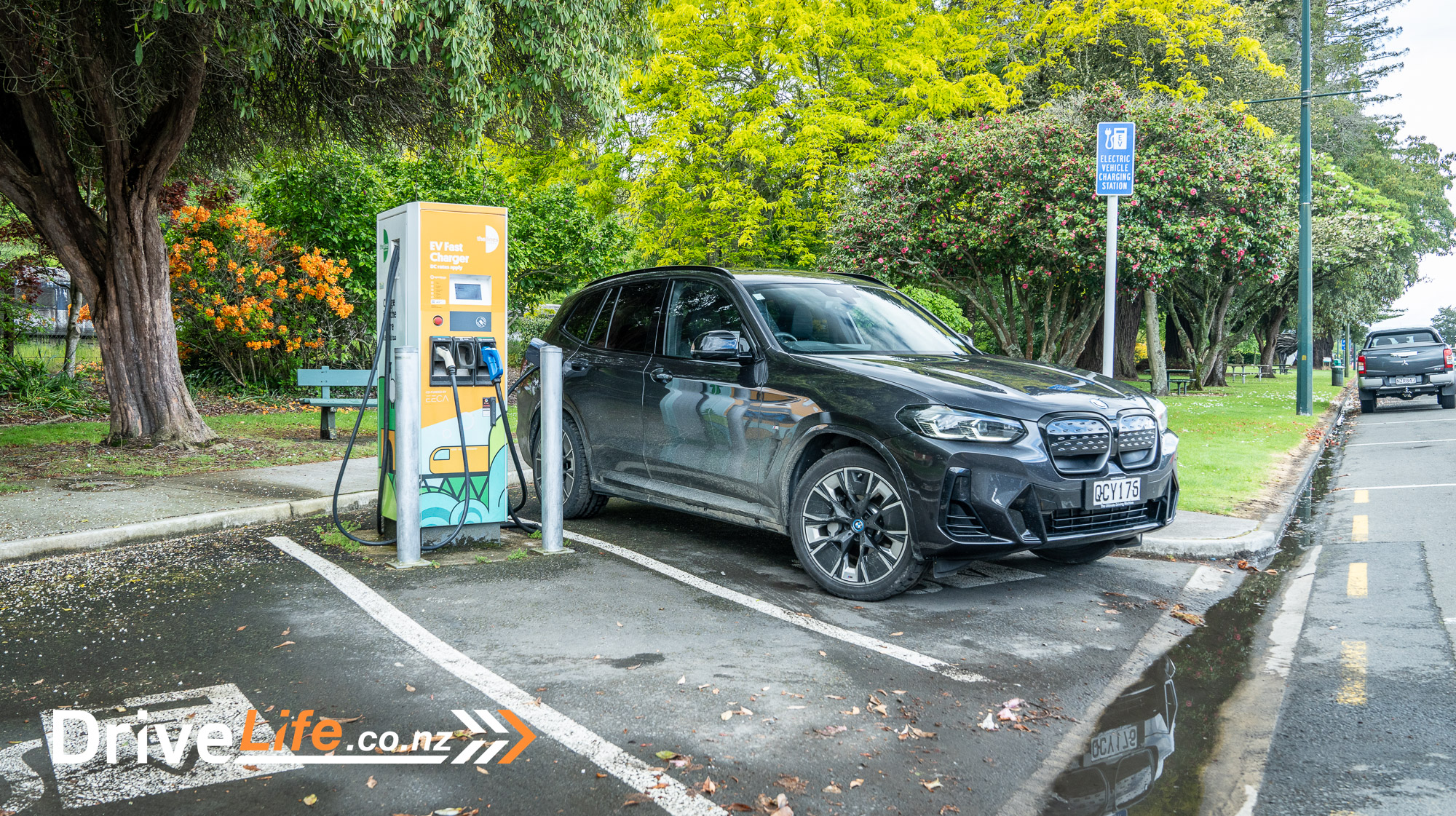




After the top-up in Taumarunui, it was time to head down SH41 and SH1 to Taupo. This route brings you down to Turangi and up around the bottom of Lake Taupo. It’s 116km from Taumarunui and estimated at around an hour and a half drive. After coming from SH43, normal roads didn’t seem to have the level of mystery to them that the Forgotten World Highway did. About 30 minutes down SH41, I came across a very understated scenic lookout point, Waituhi Lookout, which led me down a bit of a narrow bush path and into a clearing with a large metal platform on it. Once I climbed to the top of this platform, I was blown away by the view. I could see everything, from Lake Taupo to Mount Ruapehu. The photo does not do the view justice, so it’s well worth the stop if you happen to be going down SH41.

That evening I got into Taupo and had been looking forward to my stay here, as I was staying at the Hilton Lake Taupo. As expected of the Hilton, the welcome was like I stayed there every other weekend. But the bonus was that they have EV charge stations on site. There is a $20 charge for this, but this covers your charging and parking in the secure underground parking. This was great as I could check in and rest up, and so could the iX3 – ready for the next day. Something to note is that they have two charging stations, one is Tesla only and the other is universal. It is on a first-come, first-served basis unless you book in advance.

Day 3 – Sunday – Taupo
It was great to wake up to the thought of a fully charged EV, and that I would not have to pop out somewhere for an hour or more to recharge the iX3 elsewhere. Hopefully, this convenience becomes a standard feature in hotels across the country.
After so much driving the day before, Sunday was a day of rest and relaxation – something Taupo does very well – either at the Hilton Hotel or at the wide range of geothermal hot pools such as the Wairakei Terraces & Thermal Health Spa.


But if relaxation is not your thing, Taupo will cover that too with a wide range of adventure activities, from the Hukafalls Jet, to AJ Hackett Bungy or Tongariro River Rafting.
Day 4 – Monday – Taupo to New Plymouth

Monday marks the end of our long weekend trip and it was time to head back to New Plymouth. The iX3 was fully charged overnight at the hotel, so all I had to do was work out what way to go back.
From here you are left with two options, go back down the Forgotten World Highway, doing it all in reverse, or take the quicker and more travelled State Highway 30 to State Highway 3 route. This route is 276 km and takes around 3 and a half hours, the upside of this is that you get to see some of the coast road that runs down from Awakino to New Plymouth. The choice is yours, but do consider that doing SH43 in the other direction may highlight some things you didn’t see the first time around. I chose the SH30 and SH3, and once back in New Plymouth, the iX3 had over 100km range left, which meant there was no need to worry about stops or charging points on the road back.

BMW iX3 Impressive – Our Thoughts
The iX3 is a great electric vehicle, as its design is the same as the ICE (Internal Combustion Engine) variant, but it’s powered by electricity. The spec level of the iX3 is excellent and it’s as efficient as it claims to be. BMW advertised its electricity consumption from 18.5 kWh/100 km, and over the course of the weekend, I was able to maintain 19 kWh/100km, which is impressive. Information about the range didn’t seem to match as well, but I feel that’s a computer issue. BMW claimed a range of 461 km, while a full charge only indicated 355km. I felt the range was more than this, as it did not decrease with the distance that was being covered. Regardless of this, its averaging of range information allowed me easy planning and avoided any range anxiety throughout my trip. I also really like how the iX3 looks, it still has a really great sporty stance which is just as important as all the other stuff.
I have to be really honest and say that I enjoyed taking an EV down The Forgotten Highway, mainly due to how peaceful it made the trip feel. The car was quiet, the countryside was quiet, and it made the whole trip a lot more relaxing, not having a drone in the background, disturbing the picturesque surroundings.

Over the course of our weekend, the prep to set up the trip, and the ground that was covered, I spent over 1,100 km behind the wheel and I have to say the iX3 is a very capable and comfy vehicle. Outside of the charging in the article, I only had one more half battery charge to cover the 1,100km, which came to a total of $83.18. That is impressive considering I collected the car fully charged. Comparing this to my own diesel Range Rover Sport, it would have cost me over $300 to do the same trip.
Additionally, when charging the iX3, a Tesla driver pulled up in his Model 3, and asked how long I would be. I said it looked like it would be around an hour. He then asked if I would mind if he used it as it was on 2% and his car is a full EV, unlike the BMW which was a hybrid. I said, incorrectly, it’s fully electric, and that surprised him. And his first comment was “the inside is going to be way more practical than my Tesla”. This showed me that the iX3 has retained the look of a typical ICE vehicle while having all of the benefits of a fully electric vehicle.
BMW indicated that its goal in the next two years is to have 25 electrified models in its product range (by the end of 2023), with 12 of these models to be fully electric. Also in 2023, the company will have at least one fully-electric model on the roads in about 90 percent of its current market segments. Over the next decade or so, the BMW Group plans to release a total of about 10 million fully electric vehicles onto the roads.

Keep on the lookout for the next DriveLife X-Factor Weekend in the coming weeks, where we will take the BMW iX1 to the tip of New Zealand, Cape Reinga.








